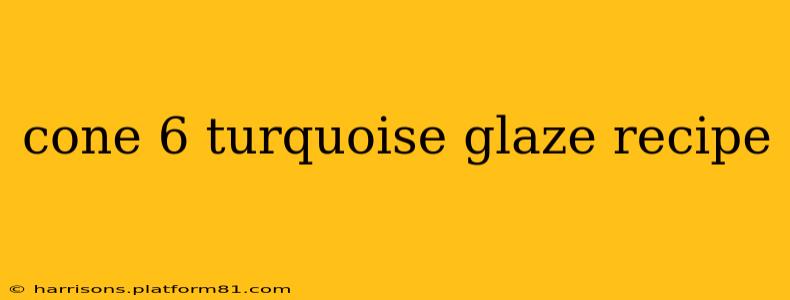Turquoise. The very word evokes images of shimmering oceans, vibrant desert skies, and ancient artifacts. Achieving this captivating color in ceramics requires precision and understanding of glaze chemistry. This comprehensive guide will explore various cone 6 turquoise glaze recipes, delve into the science behind the color, and offer troubleshooting tips to help you achieve your perfect shade.
Understanding the Chemistry of Turquoise Glazes
Before diving into specific recipes, let's understand the fundamental elements contributing to a turquoise hue. The characteristic blue-green color stems from a combination of copper and other metallic oxides. Copper alone often yields a more green or olive tone, while the addition of other elements like cobalt, chromium, or even iron can shift the color towards the desired turquoise range. The base glaze composition also plays a significant role, affecting the final color's intensity and vibrancy.
Cone 6 Turquoise Glaze Recipes: Variations and Considerations
There's no single "perfect" turquoise glaze recipe; the ideal formula depends on your specific clay body, firing schedule, and desired aesthetic. However, several reliable recipes offer a good starting point for experimentation:
Recipe 1: A Classic Copper-Based Turquoise
This recipe emphasizes copper as the primary coloring agent, resulting in a more subdued, slightly greenish turquoise.
- Ingredients:
- Feldspar: 30%
- Nepheline Syenite: 25%
- Whiting: 15%
- Custer Feldspar: 10%
- Copper Carbonate: 5%
- Zinc Oxide: 5%
- Silica: 10%
Recipe 2: Brighter Turquoise with Added Cobalt
The addition of cobalt enhances the blue tones, creating a brighter, more vibrant turquoise.
- Ingredients:
- Gerstley Borate: 30%
- EPK: 25%
- Dolomite: 15%
- Copper Carbonate: 10%
- Cobalt Carbonate: 5%
- Zinc Oxide: 10%
- Silica: 5%
Recipe 3: A Steely Turquoise with Chromium
This recipe utilizes chromium for a slightly more muted, steely turquoise.
- Ingredients:
- Feldspar: 40%
- Ball Clay: 20%
- Whiting: 10%
- Copper Carbonate: 10%
- Chromium Oxide: 5%
- Zinc Oxide: 10%
- Silica: 5%
Important Note: These are starting points. Slight adjustments in the percentages of each ingredient can significantly alter the final color. Always weigh your materials precisely and mix thoroughly.
How do I get a more intense turquoise color?
The intensity of your turquoise glaze depends heavily on the concentration of copper and the other metallic oxides. Experiment by increasing the percentage of copper carbonate in your chosen recipe (while maintaining balance to avoid glaze defects). However, be mindful that excessive copper can lead to undesirable results like blistering or crazing. Testing small batches on test tiles is crucial.
What causes my turquoise glaze to be too green or too blue?
- Too Green: This typically indicates insufficient cobalt or other blue-producing elements. Try adding a small percentage of cobalt carbonate to shift the color balance.
- Too Blue: Excess cobalt or insufficient copper can lead to a blue-dominant glaze. Adjust the proportions of copper and cobalt to achieve the desired balance.
What are the common problems encountered when firing turquoise glazes?
Common problems include blistering, crazing, and pinholing. These often stem from an imbalance in the glaze recipe, improper mixing, or variations in the firing process. Careful testing and precise measurement are key to avoid these issues. Adjusting the silica content can sometimes mitigate blistering.
What type of clay body works best with turquoise glazes?
Turquoise glazes tend to perform well on a variety of clay bodies. However, consistently high-quality results often come from mid-range clays with a balanced composition. It's crucial to test your glaze on your chosen clay body to ensure compatibility.
Can I adjust the recipes to create different shades of turquoise?
Absolutely! The beauty of glaze chemistry lies in the endless possibilities for experimentation. Slight adjustments to the ratios of the metal oxides, even substitutions with other elements like iron or manganese, can yield a vast range of turquoise shades, from light and airy to deep and rich. Remember to always document your recipes and firing conditions for consistent results.
This exploration of cone 6 turquoise glaze recipes offers a springboard for your creative endeavors. Remember, consistent testing and meticulous record-keeping are crucial for achieving your perfect shade of turquoise. Happy glazing!
